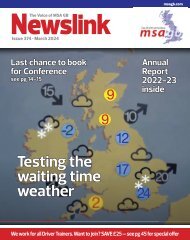MSA Newslink Marketing Special
Motor Schools Association of Great Britain Introductory magazine; membership offers and joining information for non-members
Motor Schools Association of Great Britain Introductory magazine; membership offers and joining information for non-members
You also want an ePaper? Increase the reach of your titles
YUMPU automatically turns print PDFs into web optimized ePapers that Google loves.
For all the latest news, see www.msagb.com<br />
Driving tests and passes, year by year<br />
Financial year Tests conducted Passes Pass rate<br />
2010/11 1,605,599 744,058 46.3<br />
2011/12 1,569,069 736,158 46.9<br />
2012/13 1,436,481 677,255 47.1<br />
2013/14 1,477,585 695,580 47.1<br />
2014/15 1,532,504 718,711 46.9<br />
2015/16 1,537,735 723,444 47.0<br />
2016/17 1,730,936 815,168 47.1<br />
2017/18 1,718,519 795,892 46.3<br />
2018/19 1,664,219 761,972 45.8<br />
2019/20 1,599,566 734,600 45.9<br />
2020/21 436,044 217,031 49.8<br />
the pass rate is just shy of 50 per cent,<br />
so only 160,000 of these will be a a<br />
pass. That’s a long way shy of the<br />
550,000 new drivers we have lost.<br />
A quick bit of maths suggests we’ll<br />
clear the 550,000 backlog in three and<br />
a half years (3.5 x 160,000 = 560,000).<br />
That’s how the maths comes out. And<br />
that is a best case scenario.<br />
It’s interesting that the 300 new<br />
examiners are coming in on two-year<br />
contracts, as if the DVSA expects therir<br />
work to be done by summer 2023... not<br />
a year, as it claims currently.<br />
And then there is this virus... Every<br />
hurdle that Covid-19 puts in front of the<br />
testing regime pushes back the date at<br />
which we can expect the testing system<br />
to be back at pre-pandemic levels. For<br />
instance, examiners are currently not<br />
conducting the maximum tests possible,<br />
because of Covid-related considerations.<br />
At present some DTCs are operating at<br />
six tests a day. That’s 90 per cent<br />
capacity. In stark terms, that is around<br />
200,000 tests a year fewer than in<br />
2018-19, and 90,000 fewer passes. In<br />
such a case the 300 extra examiners<br />
would do nothing to lower the waiting<br />
times; rather, they would simply stop the<br />
waiting lists growing any further, and we<br />
would be left with a 17-week waiting<br />
time as a standard in many parts of the<br />
country, rather than an exception.<br />
It is true that the DVSA is working on<br />
this part of the problem, and one<br />
assumes that every week more DTCs wil<br />
go back to pre-Covid testing numbers.<br />
But at the same time, every week that<br />
DTCs AREN’T at full capacity is a week<br />
which nudges back the day the waiting<br />
times issue is solved.<br />
The other factor to bear in mind is<br />
when the 300 turn up for work. We<br />
know that the DVSA has started the<br />
recruitment and training process, but we<br />
have no idea how long it will take for the<br />
new recruits’ boots to hit the ground and<br />
NEWSLINK SPECIAL n JUNE 2021<br />
start making a dent in the waiting list.<br />
Remember that we are still living with<br />
Covid-19 restrictions. One could easily<br />
assume that the examiner training<br />
programme is currently less efficient and/<br />
or slower than before, with fewer student<br />
examiners in cars or lecture theatres, and<br />
possibly fewer on each training cohort to<br />
maintain social distancing.<br />
There is also an assumption that new<br />
examiners won’t be expected to carry a<br />
full test load from the outset; rather, they<br />
will spend several weeks shadowing<br />
more experienced colleagues.<br />
Therefore, this numbers game is full of<br />
questions. First, when will examiners go<br />
‘‘<br />
The new 300 are coming in<br />
on two-year contracts...<br />
as if DVSA thinks the<br />
problem will be solved by<br />
summer 2023...<br />
‘‘<br />
back to full testing? Second, when will<br />
the relief column of new ones start work<br />
– and when will they be at 100 per cent<br />
operational efficiency?<br />
At the end of April, the DVSA had<br />
434,631 practical car driving tests<br />
booked. I’d estimate that this is about<br />
four months’ worth and covers the<br />
summer and into September. An<br />
additional fact: the DVSA hopes to be<br />
conducting 11,725 tests a day once<br />
social distancing rules have been lifted.<br />
That’s an increase of around 11 per cent<br />
on 2019-20 figures – way short of the<br />
18 per cent possible in terms of the extra<br />
examiners recruited.<br />
So where do all these figures leave us?<br />
Well, I think it is fair to say that they<br />
work against the DVSA goal of having the<br />
test waiting time back to 6-7 weeks<br />
within a year. There are just too many<br />
people in the system waiting to be<br />
tested, with too little extra capacity being<br />
brought in to satisfy demand. I’d expect<br />
waiting lists to stay as high as 16 weeks<br />
for at least two years. And this situation<br />
could be worse: we know there is a huge<br />
pent-up demand for theory tests. Once<br />
the rules are relaxed on social distancing<br />
so that theory test centres can get back<br />
to full capacity, there will be a tsunami of<br />
learners looking for a test. It’s going to<br />
get nasty...<br />
But there is one hope for the DVSA,<br />
one more regiment of cavalry it can<br />
deploy. And somewhat ironically, it is us<br />
ADIs.<br />
You see, there aren’t as many of us as<br />
there used to be, so no matter how many<br />
people are desperate for lessons – either<br />
those who had their training interrupted<br />
by Covid, those who never started or<br />
those who turned 17 recently and would<br />
be expecting to start – there just isn’t the<br />
ADI capacity to take them on. We are<br />
basically looking at 27 months’ worth of<br />
new pupils hitting ADIs’ books in the<br />
just 12 months – and that’s an equation<br />
that simply will not work. There are only<br />
so many extra lessons ADIs can offer,<br />
and it’s going to leave a lot of would-be<br />
learners disappointed.<br />
It’s not like there is an easy way to<br />
increase ADI numbers either. The training<br />
process takes around a year from initial<br />
application to becoming a fully vetted<br />
ADI. You can’t simply magic new ADIs<br />
out of the air after a rudimentary training<br />
period; there are standards to uphold,<br />
exams to pass. Anecdotal evidence<br />
suggests a few older ADIs who retired<br />
recently are contemplating coming back<br />
to the profession to earn a quick buck<br />
while the sun is shining, but it’s not many.<br />
And that’s the DVSA’s ace up its<br />
sleeve; it could be that the full weight of<br />
demand to take a driving test will be held<br />
back by the dam of a scarcity of ADIs to<br />
train learners quickly enough.<br />
And just as that dam looks ready to<br />
break, the DVSA will have its examiners<br />
back working at full capacity and the<br />
new recruits will be making a difference,<br />
too.<br />
So could we be back to normal by<br />
summer 2022? Unlikely; a more<br />
believable concept will be pupils fighting<br />
for test slots for at least the next two<br />
years, with waiting times fluctuating<br />
wildly from DTC to DTC, some with<br />
reasonable waiting, others not.<br />
It could definitely get messy...<br />
25

















